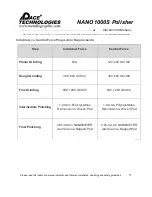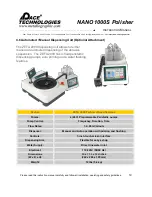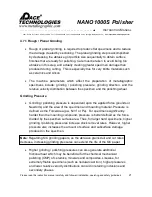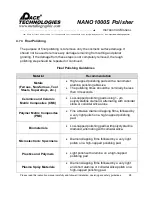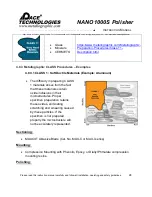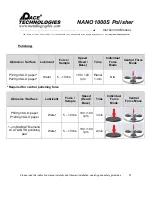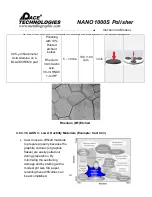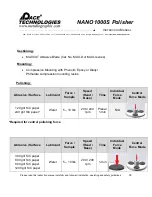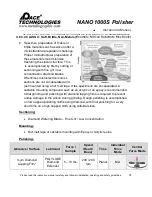
NANO 1000S Polisher
I
NSTRUCTION
M
ANUAL
- - - - - - - - - - - - - - - - - - - - - - - - - - - - - - - - - - - - - - - - - - - - - - - - - - ▲
3601 E. 34th St. Tucson, AZ 85713 USA Tel. +1 520-882-6598 Fax +1 520-882-6599 email: [email protected] W eb: https://www.metallographic.com
Please read this instruction manual carefully and follow all installation, operating and safety guidelines.
20
4.7 Metallographic Specimen Preparation Basics
A typical metallographic specimen preparation consists of the following basic steps:
Preparation Stage
Purpose
Initial Documentation:
To document the initial condition of the sample
To map the sample surface
To highlight the area of interest.
Sectioning / Cutting:
To reduce the size of large samples and to sample
the specimens close to the area of interest.
Rough, or Planar
Grinding:
To obtain a planar surface
To remove sectioning damage
To approach the area of interest.
Rough Polishing:
Ideally to remove all the subsurface damage and
microstructural damage produced during cutting and rough
grinding (Superficial scratches may still be present after this
step).
Final Polishing:
Generally, more for cosmetic purposes than for removing
microstructural damage. In most cases, this stage should
be minimized to avoid over polishing and distorting the
microstructural features.
Etching:
To enhance microstructural features such as grain
boundaries, grain size, phase differences, etc.
Examination:
A variety of examination techniques are used in
metallography, including: optical microscopy, electron
microscopy and hardness testing.












